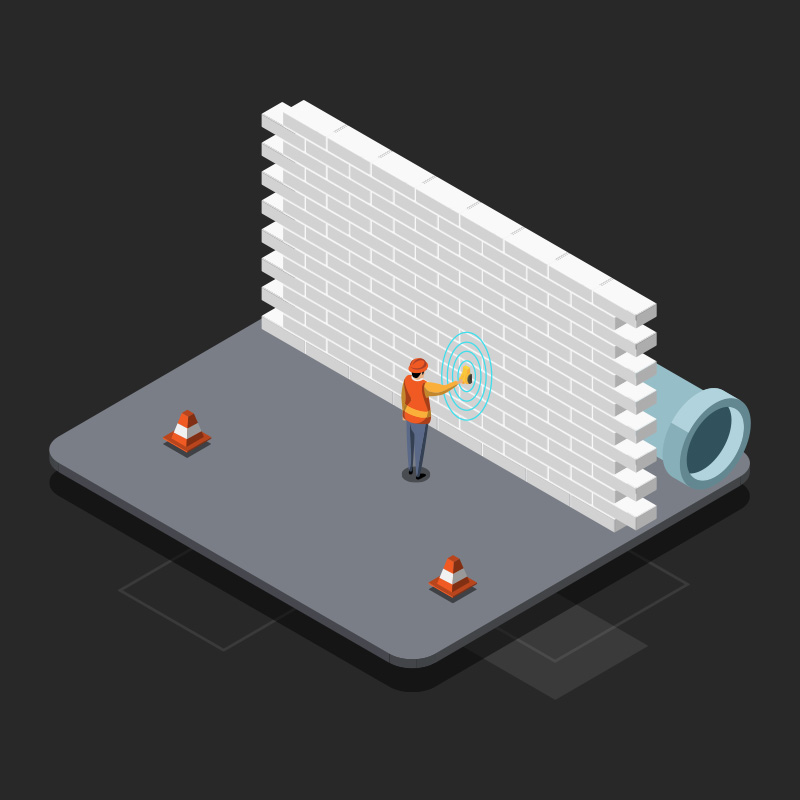Past the Surface: Leveraging Advanced Concrete Scanning Techniques for Unmatched Precision and Understanding
Advanced concrete scanning methods have actually emerged as vital tools in this quest, supplying a look below the surface to unveil a globe of critical understandings. By using advanced technologies, specialists can uncover abnormalities, evaluate the condition of concrete frameworks, and make informed decisions that form the course of projects.
Relevance of Advanced Concrete Scanning
The relevance of making use of advanced concrete scanning methods hinges on the exceptional precision they use for identifying sub-surface anomalies and ensuring structural integrity. By utilizing advanced innovations such as ground-penetrating radar (GPR), electro-magnetic induction, and advanced finder imaging, construction experts can delve underneath the surface area of concrete structures with a degree of precision that much exceeds typical inspection techniques. Concrete Scanning. These strategies make it possible for the recognition of hidden threats like rebar corrosion, voids, avenues, or post-tension cable televisions that could compromise the security and security of a framework in time
In addition, progressed concrete scanning provides vital understandings into the total condition of a concrete element without the need for invasive procedures, reducing the threat of causing damages during the assessment procedure. The capacity to determine the precise location and depth of prospective concerns permits targeted fixings and upkeep, ultimately prolonging the life-span of the structure and maximizing its performance. Essentially, the significance of advanced concrete scanning can not be overemphasized in the world of construction and facilities maintenance, where accuracy and reliability are paramount.
Sorts Of Cutting-Edge Technologies

Anomalies and Problem Discovery

Along with recommended you read GPR, concrete scanning strategies like thermography and impact-echo testing are additionally effective in finding abnormalities and issues. Thermography uses infrared modern technology to recognize variations in surface area temperature level, indicating prospective locations of issue such as delamination or wetness access. On the various other hand, impact-echo testing involves evaluating acoustic actions to find spaces, splits, and various other problems within the concrete. By leveraging these advanced strategies, experts can proactively attend to structural concerns, making certain the durability and safety and security of concrete frameworks.
Assessing Concrete Problem
Just how can designers precisely examine the condition of concrete frameworks to ensure their long life and safety and security? Examining the concrete condition is a vital aspect of maintaining infrastructure great post to read honesty. Different innovative concrete scanning methods are utilized for this purpose. Ground-penetrating radar (GPR) is frequently made use of to examine the internal framework of concrete, finding voids, splits, and other abnormalities that may jeopardize its toughness. In addition, impact-echo testing can give insights right into the density and stability of concrete aspects. Ultrasonic pulse velocity screening is another useful technique for reviewing concrete quality by gauging the original source the speed of acoustic waves through the product.
Combining non-destructive testing techniques with visual evaluations enables for a comprehensive examination of concrete problem, enabling engineers to determine possible concerns early on and implement timely upkeep or repairs. By leveraging these innovative techniques, designers can guarantee the long-term sturdiness and security of concrete frameworks.
Enhancing Decision-Making Procedures
In the world of facilities monitoring, enhancing decision-making procedures is vital for ensuring the reliable maintenance and longevity of concrete frameworks. Enhanced decision-making processes in concrete administration include using innovative scanning strategies to gather in-depth information on the condition of structures. By leveraging technologies such as ground-penetrating radar and 3D imaging, stakeholders can make enlightened choices concerning repair work, reinforcement, or substitute approaches.
These progressed scanning strategies supply vital insights into the internal make-up of concrete, identifying possible concerns such as voids, cracks, or corrosion that may not be noticeable on the surface. This degree of in-depth details permits proactive upkeep preparation, lessening the danger of structural failures and boosting the overall lifespan of concrete structures.
Additionally, by including digital documents and evaluation tools into the decision-making procedure, stakeholders can track the evolution of concrete conditions with time, enabling anticipating upkeep strategies and maximizing resource allotment. Inevitably, the assimilation of innovative concrete scanning methods enhances decision-making procedures by supplying unrivaled precision, insight, and performance in facilities administration.
Final Thought
In final thought, progressed concrete scanning strategies supply unmatched precision and insight in identifying abnormalities, problems, and evaluating the condition of concrete structures. By leveraging innovative technologies, decision-making processes can be enhanced, leading to more enlightened and efficient solutions for preserving and repairing concrete facilities. These methods play a critical function in making certain the safety and durability of concrete structures, making them a crucial device in the area of construction and design.
Moreover, progressed concrete scanning gives invaluable understandings into the overall condition of a concrete aspect without the requirement for invasive measures, minimizing the threat of causing damages during the analysis process - Concrete Scanning. One more cutting-edge modern technology is 3D X-ray scanning, which provides detailed pictures of the interior framework of concrete, supplying beneficial info without the demand for devastating screening. In Addition, Concrete Cover Meters are made use of to determine the thickness of concrete cover over reinforcement bars precisely. Improved decision-making processes in concrete administration include making use of innovative scanning strategies to gather in-depth data on the problem of structures.In conclusion, advanced concrete scanning methods provide unmatched precision and understanding in discovering abnormalities, defects, and examining the condition of concrete frameworks